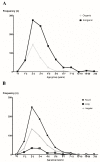Analysis of Nasal Foreign Bodies in South Korea: Over 10-Year Experience
- PMID: 36010161
- PMCID: PMC9406659
- DOI: 10.3390/diagnostics12081810
Analysis of Nasal Foreign Bodies in South Korea: Over 10-Year Experience
Abstract
Foreign bodies (FBs) in the nasal cavity are commonly encountered in otorhinolaryngology. This retrospective study was conducted between January 2009 and December 2020. The nasal FB frequencies were investigated according to age and sex. The type, shape, and location of the FBs, onset, and clinical features were obtained. In a total of 1228 cases, the average age was 3.9 ± 5.7 years. We found a higher incidence in patients 2-4 years old. The most frequent nasal FBs were beads (24.0%), toys/plastics (17.8%), and beans/corn (15.8%). However, there were some differences in the nasal FB types according to the age group. There was no difference in the location of the nasal FBs according to age group, but nasal FBs were found more frequently in the right nasal cavity in the 1-3-years-old groups. Most patients (97.5%) visited the hospital the same day when the nasal FB insertion was suspected, and most were asymptomatic. After the removal of the nasal FBs, most patients were free of complications. Of the nine cases involving button batteries, septal perforation was observed in two patients who visited the hospital one or two days after the FB insertion. There were specific age-based characteristics of the nasal FBs that may serve as a basis for specific precautions.
Keywords: batteries; complications; foreign bodies; nasal cavity; nasal septal perforation.
Conflict of interest statement
The authors declare no conflict of interest.
Figures




References
-
- Gregori D., Salerni L., Scarinzi C., Morra B., Berchialla P., Snidero S., Corradetti R., Passali D. Foreign bodies in the nose causing complications and requiring hospitalization in children 0–14 age: Results from the European survey of foreign bodies injuries study. Rhinology. 2008;46:28–33. - PubMed
Grants and funding
LinkOut - more resources
Full Text Sources

